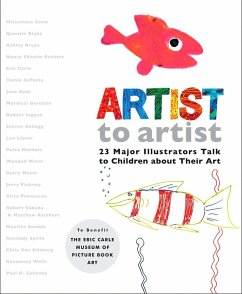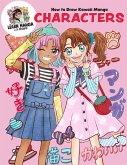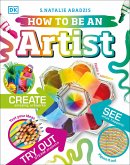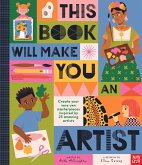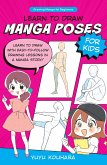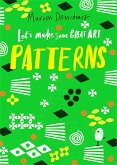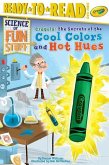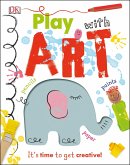Eric Carle Museum Pict Bk Art
Artist to Artist: 23 Major Illustrators Talk to Children about Their Art
Illustrator: Carle, Eric
Eric Carle Museum Pict Bk Art
Artist to Artist: 23 Major Illustrators Talk to Children about Their Art
Illustrator: Carle, Eric
- Gebundenes Buch
- Merkliste
- Auf die Merkliste
- Bewerten Bewerten
- Teilen
- Produkt teilen
- Produkterinnerung
- Produkterinnerung
Celebrating the art of the picture book, this beautiful anthology highlights the work of 23 of the most honored and beloved illustrators in childrens literature, including Maurice Sendak, Robert Sabuda, Rosemary Wells, and Eric Carle.
This gorgeous collection of art (and the artists behind it) includes work by some of the world's most renowned children's book illustrators—Mitsumasa Anno, Quentin Blake, Ashley Bryan, Nancy Ekholm Burkert, Eric Carle, Tomie dePaola, Jane Dyer, Mordicai Gerstein, Robert Ingpen, Steven Kellogg, Leo Lionni, Petra Mathers, Wendell Minor, Barry Moser, Jerry…mehr
Andere Kunden interessierten sich auch für
![How to Draw Kawaii Manga Characters How to Draw Kawaii Manga Characters]() Misako Rocks!How to Draw Kawaii Manga Characters12,99 €
Misako Rocks!How to Draw Kawaii Manga Characters12,99 €![How to Be an Artist How to Be an Artist]() DkHow to Be an Artist18,99 €
DkHow to Be an Artist18,99 €![This Book Will Make You an Artist This Book Will Make You an Artist]() Ruth MillingtonThis Book Will Make You an Artist22,99 €
Ruth MillingtonThis Book Will Make You an Artist22,99 €![Learn to Draw Manga Poses for Kids Learn to Draw Manga Poses for Kids]() Yuyu KouharaLearn to Draw Manga Poses for Kids15,99 €
Yuyu KouharaLearn to Draw Manga Poses for Kids15,99 €![Let's Make Some Great Art: Patterns Let's Make Some Great Art: Patterns]() Marion DeucharsLet's Make Some Great Art: Patterns13,99 €
Marion DeucharsLet's Make Some Great Art: Patterns13,99 €![Crayola! the Secrets of the Cool Colors and Hot Hues: Ready-To-Read Level 3 Crayola! the Secrets of the Cool Colors and Hot Hues: Ready-To-Read Level 3]() Bonnie WilliamsCrayola! the Secrets of the Cool Colors and Hot Hues: Ready-To-Read Level 316,99 €
Bonnie WilliamsCrayola! the Secrets of the Cool Colors and Hot Hues: Ready-To-Read Level 316,99 €![Play with Art Play with Art]() DkPlay with Art13,99 €
DkPlay with Art13,99 €-
-
-
Celebrating the art of the picture book, this beautiful anthology highlights the work of 23 of the most honored and beloved illustrators in childrens literature, including Maurice Sendak, Robert Sabuda, Rosemary Wells, and Eric Carle.
This gorgeous collection of art (and the artists behind it) includes work by some of the world's most renowned children's book illustrators—Mitsumasa Anno, Quentin Blake, Ashley Bryan, Nancy Ekholm Burkert, Eric Carle, Tomie dePaola, Jane Dyer, Mordicai Gerstein, Robert Ingpen, Steven Kellogg, Leo Lionni, Petra Mathers, Wendell Minor, Barry Moser, Jerry Pinkney, Alice Provenson, Robert Sabuda, Matthew Reinhart, Maurice Sendak, Gennady Spirin, Chris Van Allsburg, Rosemary Wells, and Paul O. Zelinsky. It's a remarkable and beautiful anthology that features twenty-three of the most honored and beloved artists in children's literature, talking informally to children—sharing secrets about their art and how they began their adventures into illustration. Fold-out pages featuring photographs of their early work, their studios and materials, as well as sketches and finished art create an exuberant feast for the eye that will attract both children and adults. Self-portraits of each illustrator crown this important anthology that celebrates the artists and the art of the picture book. An event book for the ages. Proceeds from the book will benefit the Eric Carle Museum of Picture Book Art in Amherst, MA.
Hinweis: Dieser Artikel kann nur an eine deutsche Lieferadresse ausgeliefert werden.
This gorgeous collection of art (and the artists behind it) includes work by some of the world's most renowned children's book illustrators—Mitsumasa Anno, Quentin Blake, Ashley Bryan, Nancy Ekholm Burkert, Eric Carle, Tomie dePaola, Jane Dyer, Mordicai Gerstein, Robert Ingpen, Steven Kellogg, Leo Lionni, Petra Mathers, Wendell Minor, Barry Moser, Jerry Pinkney, Alice Provenson, Robert Sabuda, Matthew Reinhart, Maurice Sendak, Gennady Spirin, Chris Van Allsburg, Rosemary Wells, and Paul O. Zelinsky. It's a remarkable and beautiful anthology that features twenty-three of the most honored and beloved artists in children's literature, talking informally to children—sharing secrets about their art and how they began their adventures into illustration. Fold-out pages featuring photographs of their early work, their studios and materials, as well as sketches and finished art create an exuberant feast for the eye that will attract both children and adults. Self-portraits of each illustrator crown this important anthology that celebrates the artists and the art of the picture book. An event book for the ages. Proceeds from the book will benefit the Eric Carle Museum of Picture Book Art in Amherst, MA.
Hinweis: Dieser Artikel kann nur an eine deutsche Lieferadresse ausgeliefert werden.
Produktdetails
- Produktdetails
- Verlag: Penguin Young Readers Group
- Seitenzahl: 114
- Altersempfehlung: 5 bis 8 Jahre
- Erscheinungstermin: September 2007
- Englisch
- Abmessung: 285mm x 234mm x 22mm
- Gewicht: 866g
- ISBN-13: 9780399246005
- ISBN-10: 0399246002
- Artikelnr.: 22565111
- Herstellerkennzeichnung
- Libri GmbH
- Europaallee 1
- 36244 Bad Hersfeld
- gpsr@libri.de
- Verlag: Penguin Young Readers Group
- Seitenzahl: 114
- Altersempfehlung: 5 bis 8 Jahre
- Erscheinungstermin: September 2007
- Englisch
- Abmessung: 285mm x 234mm x 22mm
- Gewicht: 866g
- ISBN-13: 9780399246005
- ISBN-10: 0399246002
- Artikelnr.: 22565111
- Herstellerkennzeichnung
- Libri GmbH
- Europaallee 1
- 36244 Bad Hersfeld
- gpsr@libri.de
I have loved picture books ever since I was a child. The illustrations of Beatrix Potter and N. C. Wyeth were early favorites, and I always found any kind of animal story irresistible. I was an enthusiastic young artist as well, and I formulated pre-school plans to make drawing the center of my lifetime career. I used to dream up stories and illustrate them for my younger sisters, Patti and Martha. We called the activity: "Telling Stories on Paper." When it took place, I would sit between them with a stack of paper on my lap and a pencil in my hand, rattling off tales and scribbling illustrations to accompany them, and passing the pictures first to one of the girls and then to the other. I enjoyed these storytelling sessions enormously and I usually persevered until my sisters were too restless to sit there any longer, or until they were buried under pieces ofpaper. I scribbled my way through elementary, junior- and senior-high school, and afterward I attended the Rhode Island School of Design, where I majored in illustration, and where I was particularly intrigued by the few projects we were given that related to the creation of picture books. I wasfortunate enough to win a fellowship that made possible a senior year of work and study in Florence, Italy. It was an exciting and fulfilling period for me, and I find that I draw constantly on the experience and images that I stored during my time there. Upon my return to the United States I did some graduate work and teaching at American University, and at the same time I began submitting picture book ideas to various publishers. Itwas an exciting moment when the first acceptances came in, and I realized that I would be able to "tell stories on paper" full-time and to a much larger audience. I loved the challenge of putting the first books together, guiding them through the various stages of the publishing process, and thenwatching them disperse into the lives of their readers. And now, twenty-five years and almost ninety books later, I still find every aspect of my involvement just as absorbing andenjoyable. During the time that I've been working on the picture books, I've lived in an old farmhouse in the hills of Connecticut which I've shared with my wife, Helen, and where I've raised six stepchildren, to whom most of my books are dedicated. Also in residence have been numerous dogs and cats, including a beloved harlequin Great Dane named Pinkerton, whose stubborn inadaptability during puppyhood inspired the book Pinkerton, Behave! The heroine of the sequel, A Rose for Pinkerton, was our senior cat, Secondhand Rose, an indcependent old grouch who was born a wild thing in the Catskill Mountains, and who devoted her long life to harassing everyone in the world, including Pinkerton. The ideas for the other books come from lots of different sources, but most of them have their roots in feelings and images that I retain from my own childhood. I try to blend illustrations and the words so that each book is a feast for the eye and ear. I want the time that the reader shares with me and my work to be an enjoyable experience -- one that will encourage a lifetime association with pictures, words, and books. Steven Kellogg talks about the art of the picture book The picture book is an art form that is designed specifically for children, but I feel that it can be appreciated and enjoyed by all ages. For centuries a distinguished tradition of illustrated books and manuscripts has existed of which the picture book is a part. It is a synthesis of literature and the visual arts, and the relationship of the written word and the picture is its essence.I am fascinated by the ways in which the picture book can borrow and combine diverse elements from other art forms to achieve startling and moving effects. The turning page, for example, gives the illustrator the chance to utilize the elements of surprise to advance the movement of the story, and to deepen the involvement of the viewer in much the same way that the theatrical director uses the revolving stages or the rising curtain between thescenes and acts of a play. An awareness of movement is extremely important in the conception of a picture book. My favorite illustrators delineate their characters so that animation is implied. The individual spreads are designed so that they crackle with graphic vitality. The characters seem to speak, cavort, andleap from the page so energetically that their life and movement are totally convincing. The moving qualities of each picture are heightened by the placement of the turning pages within the unfolding narrative and by the conception of the book as a whole. It is here that one sees the relationship between the arts of picture book design and filmmaking, as both of them deal with thephenomenon of "moving pictures." No one will deny that language can be musical, and certainly visual images can suggest different forms of music by the feelings that they convey. The musical qualities of the pictures and the words can be orchestrated by the artist as he moves them across the pages of the book. Rhythms and harmonies can be established on some spreads, and atonal effects or dissonances can be introduced on others. There are limitless possibilities available to the artist, who sets up relationships and tensionsbetween the illustrations and the text, allowing magical discoveries and subtle revelations to emerge in the areas between. When this happens, there is an uncanny fusion of all the elements,and the dynamic new expression that is created introduces young readers to the world of art. copyright © 2000 by Penguin Putnam Books for Young Readers. All rights reserved. Quentin Blake lives and works in London, Hastings, and the South West of France. He first had drawings published when he was still at school. He has worked on over 200 books, sometimes as illustrator and sometimes as the writer too. In 1999, with the help of children from over 24 schools all over Britain, Quentin was selected to be the first Children's Laureate. The children submitted a long list of questions for Quentin, here are his answers to a few of them. "Your illustrations are very recognizable. What made you illustrate the way you do?" "I am not really quite sure why I draw the way I do. It may be because I didn’t go to an art school, except for part-time lessons when I was already over twenty. But I don’t think that can be the whole explanation. It’s a kind of handwriting, and it does actually look rather like my handwriting." "Did you first start to like books because of the words or the pictures? Do you like writing as much as drawing and painting? In Clown you didn’t use words at all. Do you think stories can be told as well without words?" "I also enjoy writing words; though I think that sometimes it’s possible to tell a story entirely in pictures, as in Clown. One interesting thing about that is that it gives the reader the opportunity to invent words and I think it encourages you to think about, and perhaps discuss, what actually is going on and what the characters are thinking and feeling." "When we read we make up pictures in our heads. Do you think having lots of pictures in a book helps that or stops it happening?" "This raises a very interesting question. With my pictures, what I hope is that it encourages the reader to imagine more pictures of his own. But sometimes what the writer is putting into your head is so rich and visual that much in the way of illustration is superfluous. Probably you know the answer to this question (though I don’t think there is only one answer) better than I do." "How did you feel when they announced the winner of the Children’s Laureate? Will it help your work or get in the way? What do you want to be able to do now that you are Children’s Laureate?" "When I was told that I was winner of the Children’s Laureate I experienced quite a variety of thoughts and feelings. It was very gratifying to think that a lot of people (like you) really did like what I had done - it was an unmistakable sign of something that it is very difficult to imagine from inside yourself. At the same time I was aware of the problem (so are the organisers of the Laureateship) that, if I am not careful, it might distract me from the work of creating more books, which is what I do best. However, for a long time I was a teacher of illustration at The Royal College of Art, so I know something about how to do two jobs at once; and I hope that during my two years I shall be offered, or find, ways to encourage people to discuss words and pictures and the way they go together; and generally to rate children’s books at their true value." "Have you any advice you can give us?" "Well, difficult; because everyone is different. But I do know that, whether it is writing or drawing, you have to do a lot of it, and keep on doing it - that is the way to improvement. And don’t wait for inspiration, just start. Inspiration is some mysterious blessing which happens when the wheels are turning smoothly." "At the moment I am at work on a book about my work and the way I do it. When it comes out - it won’t be before September 2000, I’m afraid - you may find in it more extended answers to your questions; I will try to make sure they are there!" Quentin Blake has illustrated many of Roald Dahl's books, in addition to other books for children. He lives in London, England. Eric Carle is acclaimed and beloved as the creator of brilliantly illustrated and innovatively designed picture books for very young children. His best-known work, The Very Hungry Caterpillar, has eaten its way into the hearts of literally millions of children all over the world and has been translated into more than 25 languages and sold over twelve million copies. Since the Caterpillar was published in 1969, Eric Carle has illustrated more than sixty books, many best sellers, most of which he also wrote. Born in Syracuse, New York, in 1929, Eric Carle moved with his parents to Germany when he was six years old; he was educated there, and graduated from the prestigious art school, the Akademie der bildenden Kunste, in Stuttgart. But his dream was always to return to America, the land of his happiest childhood memories. So, in 1952, with a fine portfolio in hand and forty dollars in his pocket, he arrived in New York. Soon he found a job as a graphic designer in the promotion department of The New York Times. Later, he was the art director of an advertising agency for many years. One day, respected educator and author, Bill Martin Jr, called to ask Carle to illustrate a story he had written. Martin's eye had been caught by a striking picture of a red lobster that Carle had created for an advertisement. Brown Bear, Brown Bear, What Do You See? was the result of their collaboration. It is still a favorite with children everywhere. This was the beginning of Eric Carle's true career. Soon Carle was writing his own stories, too. His first wholly original book was 1,2,3 to the Zoo, followed soon afterward by the celebrated classic, The Very Hungry Caterpillar. Eric Carle's art is distinctive and instantly recognizable. His artwork was created in collage technique, using hand-painted papers, which he cut and layered to form bright and cheerful images. Many of his books have an added dimension - die-cut pages, twinkling lights as in The Very Lonely Firefly, even the lifelike sound of a cricket's song as in The Very Quiet Cricket - giving them a playful quality: a toy that can be read, a book that can be touched. Children also enjoy working in collage and many sent him pictures they have made themselves, inspired by his illustrations. He received hundreds of letters each week from his young admirers. The secret of Eric Carle's books' appeal lies in his intuitive understanding of and respect for children, who sense in him instinctively someone who shares their most cherished thoughts and emotions. The themes of his stories were usually drawn from his extensive knowledge and love of nature - an interest shared by most small children. Besides being beautiful and entertaining, his books always offer the child the opportunity to learn something about the world around them. It is his concern for children, for their feelings and their inquisitiveness, for their creativity and their intellectual growth that, in addition to his beautiful artwork, makes the reading of his books such a stimulating and lasting experience. Carle said: "With many of my books I attempt to bridge the gap between the home and school. To me home represents, or should represent; warmth, security, toys, holding hands, being held. School is a strange and new place for a child. Will it be a happy place? There are new people, a teacher, classmates - will they be friendly? I believe the passage from home to school is the second biggest trauma of childhood; the first is, of course, being born. Indeed, in both cases we leave a place of warmth and protection for one that is unknown. The unknown often brings fear with it. In my books I try to counteract this fear, to replace it with a positive message. I believe that children are naturally creative and eager to learn. I want to show them that learning is really both fascinating and fun." In 2002, Eric and his wife Barbara cofounded The Eric Carle Museum of Picture Book Art (www.carlemuseum.org) in Amherst, Massachusetts, a 40,000-square-foot space dedicated to the celebration of picture books and picture book illustrations from around the world, underscoring the cultural, historical, and artistic significance of picture books and their art form. Eric Carle passed away in May 2021 at the age of 91. His work remains an important influence on artists and illustrators at work today. copyright © 2000, 2021 by Penguin Random House LLC. All rights reserved. Tomie dePaola was born in Meriden, Connecticut, in 1934 to a family of Irish and Italian background. By the time he could hold a pencil, he knew what his life's work would be. His determination to create books for children led to a BFA from Pratt Institute in Brooklyn, New York, and an MFA from the California College of Arts & Crafts in Oakland, California. It drove him through the years of teaching, designing greeting cards and stage sets, and painting church murals until 1965, when he illustrated his first children's book, Sound, by Lisa Miller for Coward-McCann. Eventually, freed of other obligations, he plunged full time into both writing and illustrating children's books. He names Fra Angelico and Giotto, Georges Rouault, and Ben Shahn as major influences on his work, but he soon found his own unique style. His particular way with color, line, detail, and design have earned him many of the most prestigious awards in his field, among them a Caldecott Honor Award for Strega Nona, the Smithsonian Medal from the Smithsonian Institution, the Kerlan Award from the University of Minnesota for his "singular attainment in children's literature," the Catholic Library Association's Regina Medal for his "continued distinguished contribution," and the University of Southern Mississippi Medallion. He was also the 1990 United States nominee for the Hans Christian Andersen Medal for illustration. Tomie dePaola has published almost 200 children's books in fifteen different countries. He remains one of the most popular creators of books for children, receiving more than 100,000 fan letters each year. Tomie lives in an interesting house in New Hampshire with his four dogs. His studio is in a large renovated 200-year-old barn. - He has been published for over 30 years. - Over 5 million copies of his books have sold worldwide. - His books have been published in over 15 different countries. - He receives nearly 100,000 fan letters each year. Tomie dePaola has received virtually every significant recognition forhis books in the children's book world, including: - Caldecott Honor Award from American Library Association - Newbery Honor Award from American Library Association - Smithson Medal from Smithsonian Institution - USA nominee in illustration for Hans Christian Andersen Medal - Regina Medal from Catholic Library Association copyright © 2000 by Penguin Putnam Books for Young Readers. All rights reserved. Mitsumasa Anno was awarded the Hans Christian Andersen Medal, the highest honor attainable in the field of children's book illustration in 1984. His original art will be displayed at the gallery opening of The Eric Carle Museum of Picture Book Art in Northhampton, MA. Mr. Anno lives in Japan. Petra Mathers lives in Astoria, Oregon. Wendell Minor is a graduate of the Ringling School of Art and Design. His work is in the permanent collections of the Library of Congress, the Museum of American Illustration, and the NASA Art Collection at the John F. Kennedy Space Center. Jerry Pinkney has been illustrating children's books since 1964 and has the rare distinction of being the recipient of: Five Caldecott Honor Medals Five Coretta Scott King Awards Four New York Times Best Illustrated Awards (most recently 2006 Little Red Hen) Four Gold and four Silver medals from the Society of Illustrators Boston Globe Honor Book Award (John Henry 1994) In addition to his work on children's books, he is an extremely successful artist who has had eleven one-man retrospectives at venues ranging from the Museum of the National Center of Afro-American Artists to the Art Institute of Chicago. His current one-man show entitled, "Building Bridges, the Art of Jerry Pinkney" was organized by the Pittsburgh Children's Museum and will be traveling through 1998. Mr. Pinkney has illustrated for a wide variety of clients, including National Geographic , the National Parks Service, the U.S. Postal Service, the American Library Association and the Association of Booksellers for Children. Born in Philadelphia in 1939, Jerry Pinkney states, "(I) took an interest in drawing very early in my life, and at some point I realized I'd rather sit and draw than do almost anything else." While growing up in the Germantown section of Philadelphia his interest in art was supported by hisfamily -- especially by his mother. "She certainly understood me and made it clear to everyone that if art was what I wanted to pursue, then that's what she wanted to have happen. My father also became very supportive, and when I wanted to take art classes after school he found ways for me to attend." In junior high school Mr. Pinkney had a newsstand and took a drawing pad with him to work every day and sketched passersby. That was how he met the cartoonist John Liney, who encouraged him to draw and showed him the possibilities of making a living as an artist. After graduating from the commercial art program at Dobbins Vocational School, where he met his wife, author Gloria Jean Pinkney, Jerry Pinkney received a full scholarship to attend the Philadelphia Museum College of Art (now University of the Arts). While at PCA he and Gloria married. After their first child was born, they moved to Boston, where Mr. Pinkney worked as a designer at Rustcraft Greeting Card Company, and at Barker-Black Studio where he developed his reputation as an illustrator. Eventually he opened Kaleidoscope Studio with two other artists. Later he opened his own freelance studio -- Jerry Pinkney Studio -- and moved to New York. Sensitivity to and an interest in a variety of cultures has always been a dominant theme of Mr. Pinkney s work. He has also drawn inspiration for a significant part of his work from African American culture. Among his numerous projects are his twelve postage stamps for the U.S. Postal Service Black Heritage series. Mr. Pinkney was a member of its Advisory Committee for ten years and he was also invited to join the NASA artist team for the space shuttle Columbia. "I wanted to show that an African American artist could make it on a national level in the graphic arts. I want to be a strong role model for my family and for other African Americans." Many of Mr. Pinkney's children's books celebrate multicultural and African American themes. "Working on both the Uncle Remus tales and John Henry has shown me an important link between pivotal and opposite African American folk heroes. Brer Rabbit, the sly trickster, originated during slavery and was the first African American folk hero. Slaves who wanted to get the better of their masters needed to be cunning and sly -- hence the trickster role. However, later comes John Henry, a free man, whose strength and valor bring him fame. He was a strong folk hero for African Americans, a symbol of all the working men who made a major contribution to the building of the roads and railroads in the mountains of West Virginia -- a dangerous job for which many paid with their lives." Mr. Pinkney's two latest books areThe Little Red Hen and The Old African by Julius Lester (illustrated by Jerry Pinkney). Books give me a great feeling of personal and artistic satisfaction. When I'm working on a book, I wish the phone would never ring. I love doing it. My satisfaction comes from the actual marks on the paper, and when it sings, it's magic". Jerry and Gloria Pinkney live in Westchester County, New York. The Pinkneys have four children: Troy, Scott, Brian, and Myles, and seven grandchildren. Two of the Pinkney's children are also involved in children's book illustration, Brian through illustrations, and Myles throughphotography. In addition to illustrating children's books and other projects, Mr. Pinkney has also been an art professor at the University of Delaware and State University of New York at Buffalo. He has given workshops and been a guest lecturer at universities and art schools across thecountry. copyright © 2007 by Penguin Putnam Books for Young Readers. All rights reserved. Gennady Spirin was born in 1948 in a small city near Moscow. A graduate of the Strogonov Academy of Fine Arts, he is noted for his beautiful illustrations, meticulously researched and exquisitely executed in pencil and watercolor. His work has brought him international renown as many awards, including the Gold Medal of the Society of Illustrators, the Golden Apple of the Bratislava International Biennale of children's book illustration, First Prize for Illustration at the Barcelona International Children's Book Fair, and the Premio Grafico at the Bologna Children's Book Fair. His book Gulliver's Adventures in Lilliput (retold by Ann Keay Beneduce) was chosen one of the Ten Best Illustrated Books of the Year by the New York Times Book Review. Gennady Spirin came to the United States in 1991 and now lives with his wife and their three sons in Princeton, New Jersey.copyright ? 2000 by Penguin Putnam Books for Young Readers. All rights reserved. Born in New York City, Rosemary Wells grew up in a house "filled with books, dogs, and nineteenth-century music." Her childhood years were spent between her parents' home near Red Bank, New Jersey, and her grandmother's rambling stucco house on the Jersey Shore. Most of her sentimental memories, both good and bad, stem from that place and time. Her mother was a dancer in the Russian Ballet, and her father a playwright and actor. Mrs. Wells says, "Both my parents flooded me with books and stories. My grandmother took me on special trips to the theater and museums in New York. When I was two years old I began to draw and they saw right away the career that lay ahead of me and encouraged me every day of my life. As far back as I can remember, I did nothing but draw." A self-proclaimed "poor student," Wells attended the Museum School in Boston after finishing high school. It was, she recalls, "a bastion of abstract expressionism an art form that brought to my mind things I don't like to eat, fabrics that itch against the skin, divorce, paper cuts, and metallic noises." Without her degree, she left school at 19, married, and began a fledgling career as a book designer with a Boston textbook publisher. When her husband, Tom, applied to the Columbia School of Architecture two years later, the couple moved to New York, where she began her career in children's books working as a designer at Macmillan. It was there that she published her first book, an illustrated edition of Gilbert & Sullivan's I Have a Song to Sing-O. Rosemary Wells's career as an author and illustrator spans more than 30 years and 60 books. She has won numerous awards, and has given readers such unforgettable characters as Max and Ruby, Noisy Nora, and Yoko. She has also given Mother Goose new life in two enormous, definitive editions, published by Candlewick. Wells wrote and illustrated Unfortunately Harriet , her first book with Dial, in 1972. One year later she wrote the popular Noisy Nora. "The children and our home life have inspired, in part, many of my books. Our West Highland white terrier, Angus, had the shape and expressions to become Benjamin and Tulip, Timothy, and all the other animals I have made up for my stories." Her daughters Victoria and Beezoo were constant inspirations, especially for the now famous "Max" board book series. "Simple incidents from childhood are universal," Wells says. "The dynamics between older and younger siblings are common to all families." But not all of Wells' ideas come from within the family circle. Many times when speaking, Mrs. Wells is asked where her ideas come from. She usually answers, "It's a writer's job to have ideas." Sometimes an idea comes from something she reads or hears about, as in the case of her recent book, Mary on Horseback, a story based on the life of Mary Breckenridge, who founded the Frontier Nursing Service. Timothy Goes to School was based on an incident in which her daughter was teased for wearing the wrong clothes to a Christmas concert. Her dogs, west highland terriers, Lucy and Snowy, work their way into her drawings in expression and body position. She admits, "I put into my books all of the things I remember. I am an accomplished eavesdropper in restaurants, trains, and gatherings of any kind. These remembrances are jumbled up and changed because fiction is always more palatable than truth. Memories become more true as they are honed and whittled into characters and stories." Mrs. Wells says, "Most of my books use animals rather than children as characters. People always ask why. There are many reasons. First, I draw animals more easily and amusingly than I do children. Animals are broader in range--age, time, and place--than children are. They also can do things in pictures that children cannot. They can be slapstick and still real, rough and still funny, maudlin and still touching. In Benjamin and Tulip, Tulip falls out of a tree and mashes Benjamin in the mud. If these pictures were of children, they would be too close to violent reality for comfort, and all the humor would be lost." Her writing career has been a "pure delight," she says. "I regret only that I cannot live other lives parallel to my own. Writing is a lonely profession and I am a gregarious sort of person. I would like someday to work for the FBI. A part of me was never satisfied with years of tennis. I still yearned

